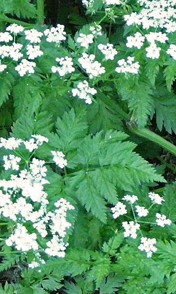 Also called wild chervil, this herbaceous biennial or short lived perennial is a native of Europe, western Asia and parts of Africa but is a common weed in parts of North America. It is member of the parsley family (Apiaceae/Umbelliferae) along with poison hemlock and Queen Anne’s lace, which it resembles. Cow parsley prefers rich, moist soil but tolerates less and can be found growing in pastures, on roadsides, and on forest edges.
Also called wild chervil, this herbaceous biennial or short lived perennial is a native of Europe, western Asia and parts of Africa but is a common weed in parts of North America. It is member of the parsley family (Apiaceae/Umbelliferae) along with poison hemlock and Queen Anne’s lace, which it resembles. Cow parsley prefers rich, moist soil but tolerates less and can be found growing in pastures, on roadsides, and on forest edges.
Description
The first year the plant produces a rosette of leaves and a taproot that can grow up to six feet long. The tripinate leaves are shiny, dark green, fern-like and up to almost twelve inches long. In mid-spring to early summer of the second year hallow, grooved, branched stems grow up to six feet tall carrying smaller leaves and terminating in flat clusters of small white flowers up to three inches wide. An abundance of small, shiny black seeds ripen in summer.
Control
Since cow parsley spreads primarily by seed control measures should aim at preventing the plant from flowering. Digging young plants as they appear in spring is the easiest method of elimination as digging more mature plants is difficult because of the long tap root which must be removed entirely. Mowing the plant weekly followed by an application of an herbicide containing a selective herbicide such as aminopyralid (marked as Milestone) may be necessary for large stands. Once the plants have flowered mowing will spread the seed and should be stopped.
To buy Milestone Specialty Herbicide with aminopyralid from Amazon.com click here.